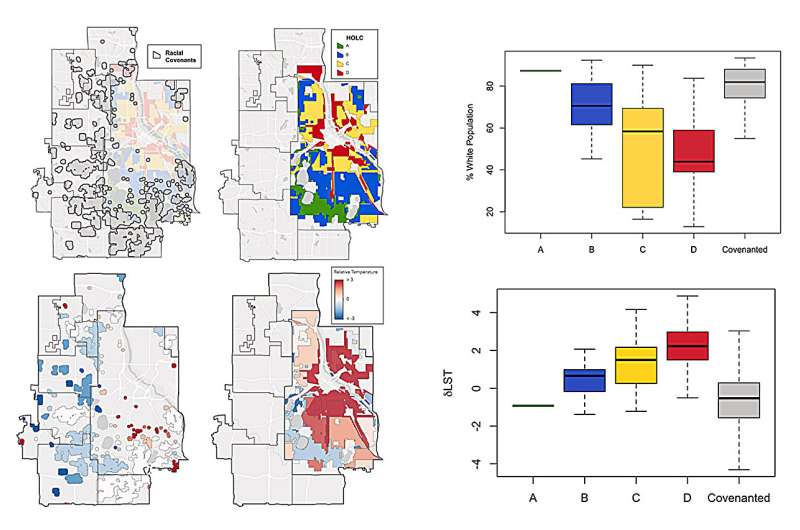This article has been reviewed according to Science X's editorial process and policies. Editors have highlighted the following attributes while ensuring the content's credibility:
fact-checked
trusted source
proofread
Study: Historic racial covenants in property deeds linked to disparities in exposure to dangerous heat

Historic racial discrimination in property ownership is linked to reduced exposure to dangerous heat today, according to the first study to analyze the environmental impact of racial covenants in property deeds.
The study looked at the city of Minneapolis and its suburbs and found that places where historic racial covenants existed had lower temperatures, more tree canopy and less area covered by impervious surfaces. It was led by University of Illinois Urbana-Champaign urban and regional planning professor Rebecca Walker.
The results are published in Landscape and Urban Planning.
Extreme heat is a serious public health issue that kills more people annually in the U.S. than flooding, tornadoes and hurricanes combined, so it is important to know who is exposed to extreme heat, Walker said.
The study used a new database created by the Mapping Prejudice project that plotted the presence of racial covenants in Minneapolis and its suburbs. It is the first such dataset for a U.S. metropolitan area, she said.
Racial covenants were clauses in property deeds that prevented the sale or occupancy of a property by a person of color. They were a widespread real estate practice in cities all over the U.S. as "a key tool for city governments and also real estate developers to do the work of segregation," Walker said. Examining their use provides a look at the development of suburbs and white flight.
They were first used in Minneapolis in 1910 and were used at least until 1955. The Supreme Court ruled them unenforceable in 1948, but they were still added to property deeds after that, she said.
Other studies have examined the environmental impact of discriminatory mortgage lending, or redlining, using maps created by the Home Owners' Loan Corp. that graded neighborhoods on their perceived risk for mortgage lending. The maps were linked to discriminatory lending practices by the federal government, Walker said. The racial covenant data covers a larger geographic area and a longer period than that during which the HOLC redlining maps were used.
"Racial covenants involved a range of actors—individual homeowners, real estate developers and local government officials—that are not necessarily held accountable by analyses that focus solely on federal redlining. In demonstrating the environmental legacy of racial covenants, we contribute to a more accurate and robust understanding of how urban environmental inequalities were produced," Walker wrote in the article detailing the study's results.
She said that this understanding is an essential first step in developing the planning approaches needed to effectively confront these inequalities today.
Walker and her colleagues looked at data for land surface temperature, tree cover and impervious surfaces in places with and without historic racial covenants, and they also compared the areas covered by the redlining maps. They found that properties that historically had racial covenants are 1.89 degrees Fahrenheit cooler than the average for Minneapolis and its suburbs, 3.7 degrees cooler than just the city average, and 0.6 degrees cooler when looking at only residential parcels with or without covenants. The properties with covenants had 10.93% more tree canopy and 3.75% less impervious surface cover than the study area average.
Racial covenants had little effect in expensive neighborhoods where only the most affluent families could afford to live. They had the most impact in middle- and lower-income neighborhoods, the study found.
Describing the historic use of racial covenants in middle- and lower-income neighborhoods, Walker said, "Those neighborhoods have the potential to become more racially mixed and (the covenants) are trying to preserve that space for white people."
She said the environmental benefits seen in the affluent areas and the areas with historic racial covenants are likely driven by both public and private investment. Wealthier homeowners can afford bigger yards and to plant more trees. Cities are more likely to protect places with high property values, and park boards created new green spaces in white neighborhoods, Walker said.
As a result, low-income communities and communities of color are disproportionately exposed to higher temperatures and lower tree canopy cover than higher-income and predominantly white communities. Tree canopy not only helps dissipate heat; it also improves air quality. More roads, parking lots and buildings contribute to heat exposure, and they increase the risk of flooding and water pollution, Walker said.
"Historic and present-day environmental quality was shaped by government-sanctioned discriminatory policies. Extreme heat exposure during heat waves can be life threatening, and here we show that the policies of the past like racial covenants, in addition to redlining, shape whose lives are threatened by dangerous heat and who is protected from this health impact," Walker wrote in the article.
She said the study will help researchers and planners to think more broadly about how the geographies of segregation and unequal environmental benefits are linked to specific policies, identify who benefited and who was harmed, and include the latter in defining solutions.
"We're all part of this. Our local city governments allowed this to happen and partnered with real estate developers, and white homeowners bought into it and benefited from it," Walker said.
More information: Rebecca H. Walker et al, The impacts of racially discriminatory housing policies on the distribution of intra-urban heat and tree canopy: A comparison of racial covenants and redlining in Minneapolis, MN, Landscape and Urban Planning (2024). DOI: 10.1016/j.landurbplan.2024.105019
Provided by University of Illinois at Urbana-Champaign




















